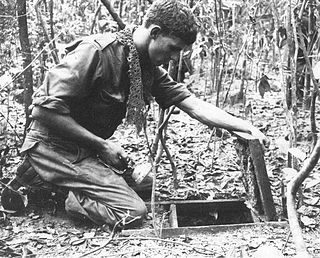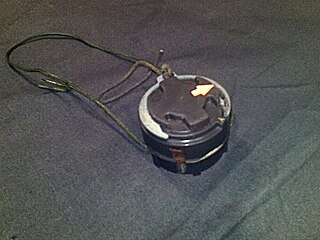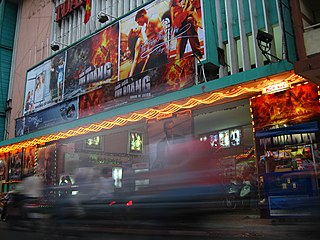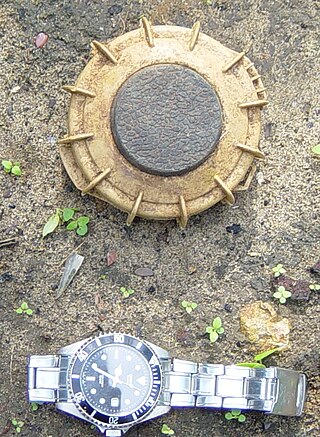Related Research Articles

A land mine, or landmine, is an explosive weapon concealed under or camouflaged on the ground, and designed to destroy or disable enemy targets, ranging from combatants to vehicles and tanks, as they pass over or near it.

A booby trap is a device or setup that is intended to kill, harm or surprise a human or another animal. It is triggered by the presence or actions of the victim and sometimes has some form of bait designed to lure the victim towards it. The trap may be set to act upon trespassers that enter restricted areas, and it can be triggered when the victim performs an action. It can also be triggered by vehicles driving along a road, as in the case of improvised explosive devices (IEDs).

The tunnel rats were American, Australian, New Zealander, and South Vietnamese soldiers who performed underground search and destroy missions during the Vietnam War.

The tunnels of Củ Chi are an immense network of connecting tunnels located in the Củ Chi District of Ho Chi Minh City (Saigon), Vietnam, and are part of a much larger network of tunnels that underlie much of the country. The Củ Chi tunnels were the location of several military campaigns during the Vietnam War, and were the Viet Cong's base of operations for the Tết Offensive in 1968.

Estimates of casualties of the Vietnam War vary widely. Estimates can include both civilian and military deaths in North and South Vietnam, Laos, and Cambodia.

Insurgency weapons and tactics (IWAT) are weapons and tactics, most often involving firearms or explosive devices, intended for use by insurgents to engage in guerrilla warfare against an occupier, or for use by rebels against an established government. One type of insurgency weapon are "homemade" firearms made by non-professionals, such as the Błyskawica (Lightning) submachine gun produced in underground workshops by the Polish resistance movement. One weapon that is part of the conventional military arsenal but which has been taken up to great effect by insurgents, is the RPG. Two examples of an improvised weapon used by insurgents would be the improvised explosive devices used in Iraq and the Molotov cocktails used against vehicles and tanks. Two tactics used by many insurgents are assassinations and suicide bomb attacks. The latter tactic is used when an insurgent has a bomb strapped to them or in their car, which provides a low-tech way for insurgents to get explosives close to critical enemy targets.

The Vietnamese famine of 1944–45 was a famine that occurred in northern Vietnam in French Indochina during World War II from October 1944 to late 1945, which at the time was under Japanese occupation from 1940 with Vichy France as an ally of Nazi Germany in Western Europe. Between 400,000 and 2 million people are estimated to have starved to death during this time.

Bernard B. Fall was a prominent war correspondent, historian, political scientist, and expert on Indochina during the 1950s and 1960s. Born in Austria, he moved with his family to France as a child after the Anschluss. He started fighting for the French Resistance at the age of 16 and later for the French Army during World War II.

The M14 mine "Toepopper" is a small anti-personnel land mine first deployed by the United States circa 1955. The M14 mechanism uses a belleville spring to flip a firing pin downwards into a stab detonator when pressure is applied. Once deployed, the M14 is very difficult to detect because it is a minimum metal mine, i.e. most of its components are plastic. Because of this, the design was later modified to ease mine clearance with the addition of a steel washer, glued onto the base of the mine.

The M16 mine is a United States-made bounding anti-personnel mine. It was based on captured plans of the World War II era German S-mine and has similar performance. The mine consists of a cast iron body in a thin steel sleeve. A central fuze well on the top of the mine is normally fitted with a pronged M605 pressure/tension (tripwire) fuze. Sufficient pressure on the prongs or tension on an attached tripwire causes the release of a striker. The freed striker is forced into a percussion cap which ignites a short pyrotechnic delay. The purpose of this delay is to allow the victim to move off the top of the mine, to prevent its upward movement from being blocked. Once the delay has burned through, a 4.5-gram black powder charge is ignited, which launches the inner iron body of the mine up into the air. The charge also ignites a second pair of pyrotechnic delays.

The cinema of Vietnam originates in the 1920s and was largely influenced by wars that have been fought in the country from the 1940s to the 1970s.

An anti-personnel mine or anti-personnel landmine (APL) is a form of mine designed for use against humans, as opposed to an anti-tank mine, which target vehicles. APLs are classified into: blast mines and fragmentation mines; the latter may or may not be a bounding mine.

VC and PAVN battle tactics comprised a flexible mix of guerrilla and conventional warfare battle tactics used by Viet Cong (VC) and the North Vietnamese People's Army of Vietnam (PAVN) to defeat their U.S. and South Vietnamese (GVN/ARVN) opponents during the Vietnam War.
A cartridge trap is a type of booby trap devised by the Viet Cong and subsequently used against American and other anti-Communist forces supporting South Vietnam during the Vietnam War. It derives its name from the fact that the wounding component of the trap is a small arms cartridge.

The Khmer People's National Liberation Armed Forces (KPNLAF) was the military component of the Khmer People's National Liberation Front (KPNLF) a political front organized in 1979 in opposition to the Vietnamese-installed People's Republic of Kampuchea (PRK) regime in Cambodia. The KPNLAF was loyal to Son Sann, a former Prime Minister under Prince Norodom Sihanouk and the founder of the KPNLF political movement.

Plain of Reeds is an inland wetland in Vietnam's Mekong Delta. Most of the wetlands are within Long An Province and Đồng Tháp Province.
The Protocol on Prohibitions or Restrictions on the Use of Mines, Booby-Traps and Other Devices is a United Nations treaty that restricts the use of land mines, remotely delivered mines, and booby traps. It is Protocol II to the 1980 Convention on Certain Conventional Weapons.
Operation Cochise Green was a security and pacification operation during the Vietnam War conducted by the 173rd Airborne Brigade in Bình Định Province from 30 March 1968 to 31 January 1969.

The Battle of Cao Ba Lanh was part of the Battle of Móng Cái, fought during the Sino-Vietnamese War between February and March 1979 near the city of Móng Cái and other districts of Quảng Ninh Province that bordered the People's Republic of China. The battle broke out as Chinese People's Liberation Army (PLA) units launched diversionary attacks in support of the Chinese invasion in the major fronts of Lạng Sơn, Cao Bằng and Lào Cai. A Chinese regiment clashed with a Vietnamese platoon, taking heavy casualties to seize the strategic peak which was later recaptured by reinforcements.

Ukraine globally ranks as one of the states with the highest civilian casualties from landmines and unexploded ordnances, and the highest for anti-vehicle mine incidents. As of April 2023, it is estimated that approximately 174,000 square kilometers of Ukrainian territory are contaminated by landmines. Many types of landmines have been found in use in Ukraine, including novel variants. Though landmines have been in use since 2014 in Ukraine during the War in Donbas (2014–2022), their use was relatively sporadic until the Russian invasion of Ukraine. According to Human Rights Watch, both Russian and Ukrainian government forces have utilized antipersonnel and anti-vehicle mines.
References
- ↑ Landmine Monitor Report - Page 514 1999 - "Use - Mines were used in all phases of the war in Vietnam, including by the French forces in the 1950s.7" [footnote] "7. International Committee of the Red Cross. Landmines, Friend or Foe? Geneva, March 1996"
- ↑ John L. Plaster SOG: the secret wars of America's commandos in Vietnam 1997 "Mining a back trail was easy using the M-14 "toe popper," a mine that was the diameter of a soda can but only one-third as long ... Designed to injure one foot — hence its nickname — the toe popper was compact and carried by the dozen."
- ↑ The Rotarian - Feb 2011 - Page 34 Vol. 189, No. 8 "The M14 blast-type anti-personnel mine used by the United States during the Vietnam War was known as the "toe-popper." Earlier examples of the toe-popper were the Soviet-made PMK-40 and the British-made "ointment box."
- ↑ Marvin G. Jensen Strike swiftly!: the 70th Tank Battalion from North Africa to Normandy to Germany 1997 "(Shermans with drums protruding in front with heavy chains that "flailed" the ground, exploding mines close to the surface.) Also there were "ointment box" mines, so called because that was what they resembled."
- ↑ Lawson, Don (1981). The United States in the Vietnam war . Crowell. p. 58. ISBN 978-0-690-04104-0. "Dap loi were made from empty .50 caliber machine gun shells that were filled with new powder and chunks of scrap ... They included carefully concealed land mines, grenades triggered by hidden trip wires placed alongside jungle trails or on.."
- ↑ vnmilitaryhistory.net "Thí dụ, chế tạo đạp lôi từ đạn súng trường, súng máy; cải tiến pháo thu được của địch để làm mìn, v.v… Đạp lôi - vũ khí lợi hại của chiến tranh nhân dân." đạp lôi (photo)
- ↑ "Mìn muỗi ngòi nụ xùy. 24. Mìn lá kiểu Bến Tre"
- ↑ What Can You Do to Help Our World?: Dreams Turned Into Reality - Page 35 Barbara Wolf, Margaret Anderson - 2012 "At first, the foundation's concentration was on Vietnam because land mines in the Vietnam War resulted in 20% amputee casualties within the Vietnam population. Returning American veterans appealed to Dr. Burgess to help the victims."
- ↑ Landmines: A Deadly Legacy - Page 18 Physicians for Human Rights (U.S.) - 1993 - 510 pages - Full view Vietnamese forces, which used several dozen types of improvised or simply manufactured mines, proved that advanced technology was not needed to deploy landmines with deadly effectiveness. In 1965, one year for which detailed statistics are available, 65–70% of US Marine Corps casualties were caused by mines and booby-traps....
- ↑ Congressional Record - Page 20595 Congress -""Fact is, anti-personnel land mines were the leading cause of our casualties in Vietnam," Muller said, "and they are the leading cause of casualties for our peacekeepers through NATO and the UN," not to mention the peril they now pose "
- ↑ Landmine Monitor Report - Page 726 2003 Total US humanitarian mine action funding to Vietnam was $3.638 million in US fiscal year 2002. ... in April 2002 for assistance in clearing mines and UXO along the route of the Ho Chi Minh Highway.90 International NGOs working in mine ..."